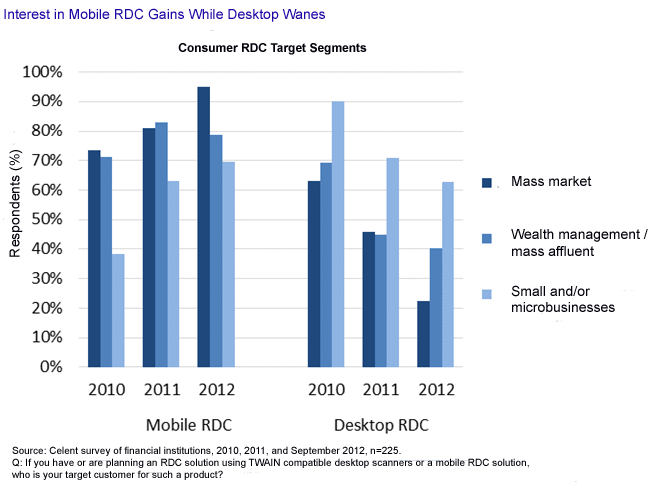Mobile remote deposit capture is destined for mainstream consumer adoption, while its desktop cousin will be shunned by most banks.
Remote deposit capture (RDC) began as a product offered to business clients using specialized capture devices. The past few years have seen several hundred financial institutions, mostly credit unions, offering consumer capture using devices consumers already own, thus eliminating the cost of providing and supporting scanners. RDC thus has become a viable self-service deposit channel; that is, for anyone with a scanner, a demographic that excludes most US households but includes virtually all small businesses. More popular still is mobile RDC, which invites the use of smartphones, running a stand-alone application or as part of a broader mobile banking solution.
According to the report featuring results of a Celent survey, State of Consumer RDC 2012: The Death of Desktop, 80% of US financial institutions are planning to or considering offering mobile RDC. Celent expects the number of financial institutions offering mobile RDC to double over the next year to nearly 1,000 banks and credit unions. Desktop RDC using scanners or multifunction devices will be offered primarily to small businesses, as financial institutions increasingly view mobile as the platform of choice for consumers.

“Widespread adoption of mobile RDC is a given, but it won’t necessarily be easy,” says Bob Meara, Senior Analyst with Celent’s Banking Group and author of the report. “Balancing regulatory compliance, risk management, and growing consumer demand will challenge many institutions.”
The other challenge with mobile RDC may result from its success with consumers and small businesses. Self-service deposits are at odds with the pervasive cross-selling culture at most banks. Reduced branch traffic presents a sales challenge, but deposit-related foot traffic comes at a significant cost—one that US banks may no longer be able to afford. Mobile RDC may hasten the branch transformation we all know to be inevitable, and many banks aren’t ready for that.
Leveraging self-service channels is an established strategy, but not in the realm of check deposits. With consumer RDC, financial institutions have a means of reducing transactional activity in their branch networks. In addition to looking at adoption motives and barriers, this report reviews RDC risk and compliance options, the consumer RDC solution provider landscape, and market opportunity for mobile RDC in the mass market, wealth management, and small business market segments. This report draws on results from a July survey of 15 solution providers and a September online survey that drew responses from 225 financial institutions.
The 56-page report contains 52 figures and 8 tables.





